
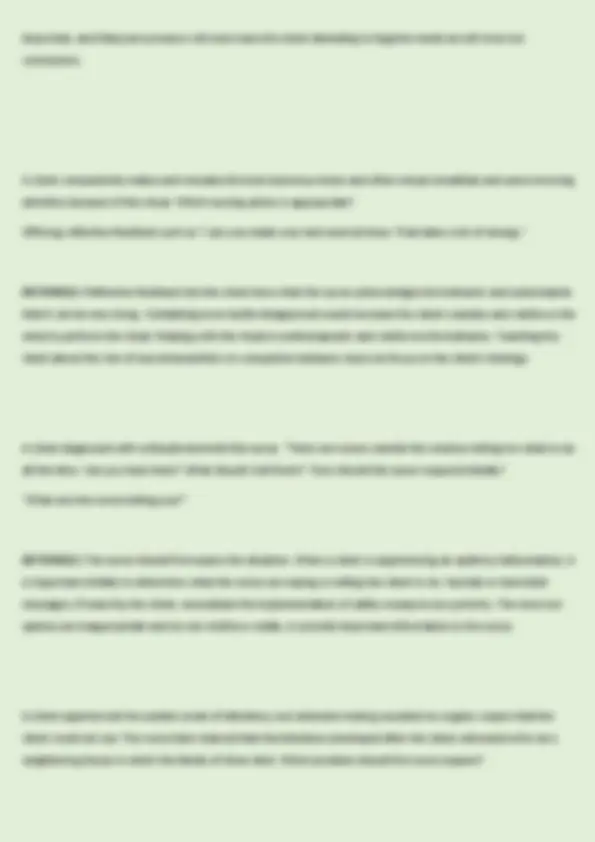
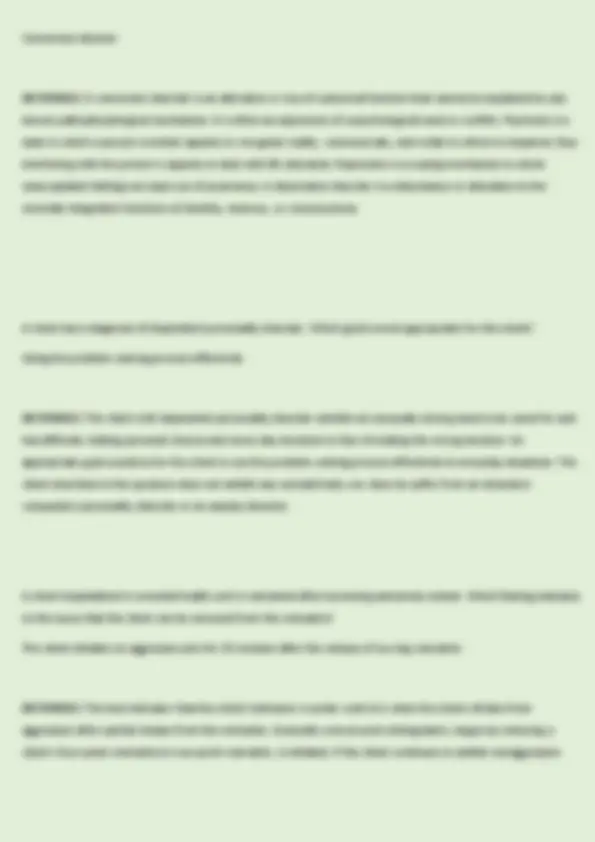
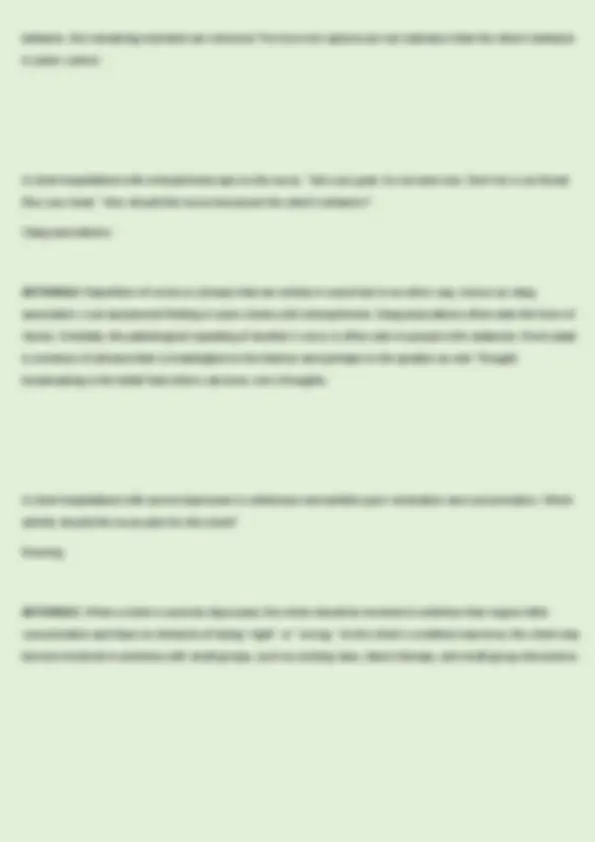
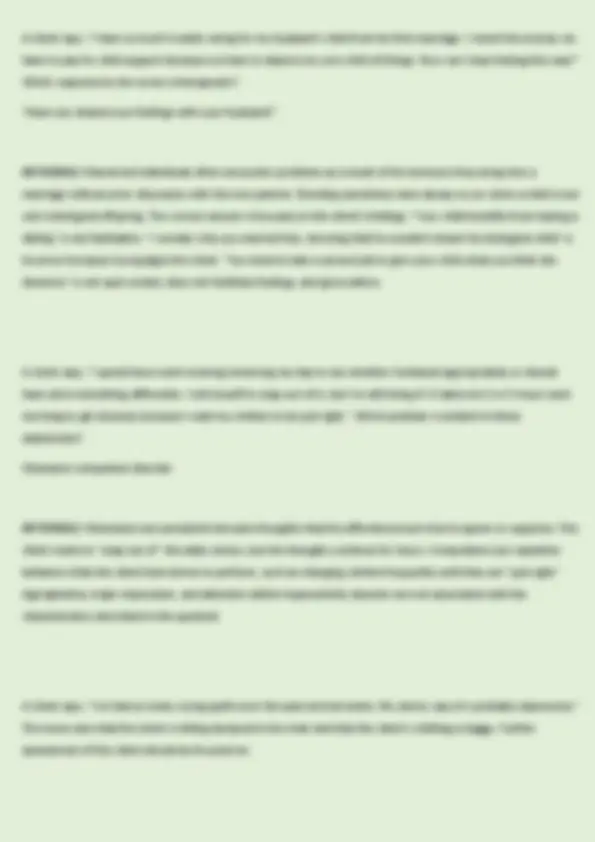
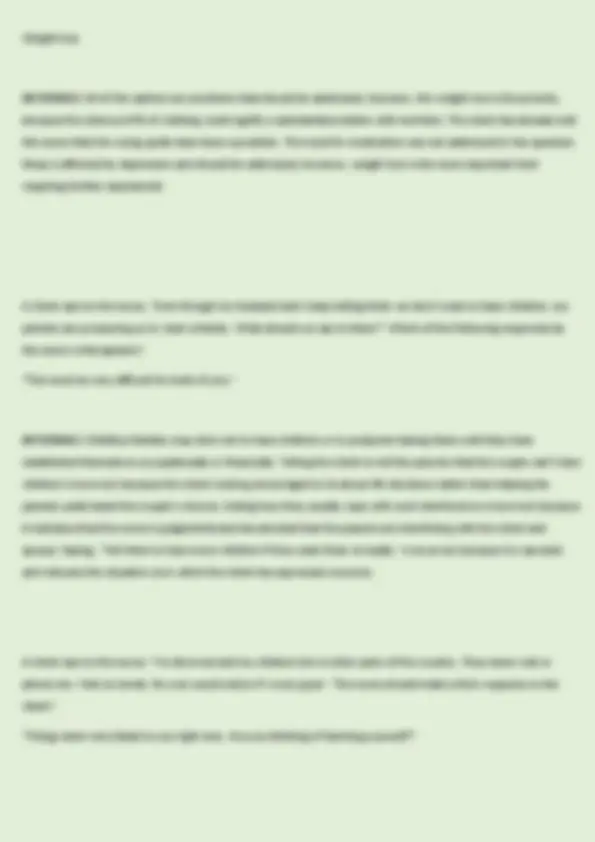
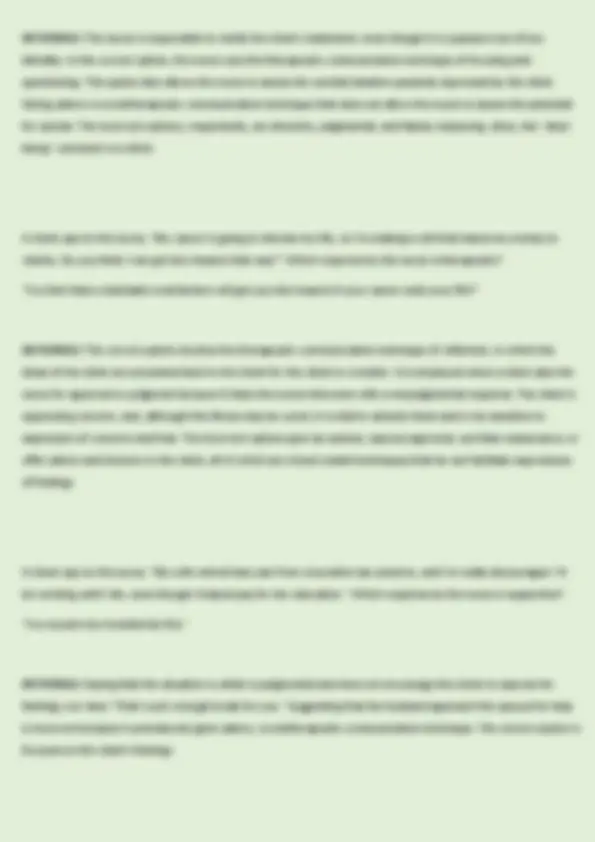
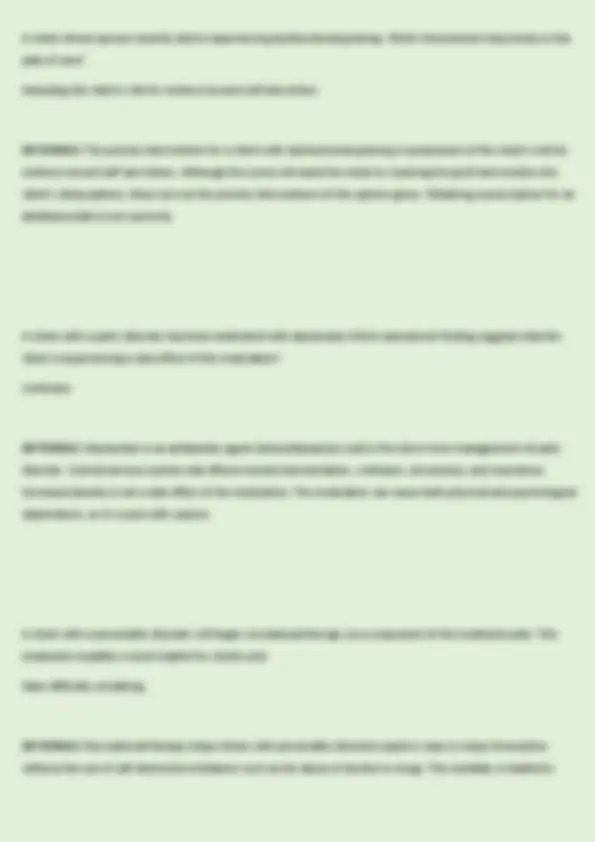

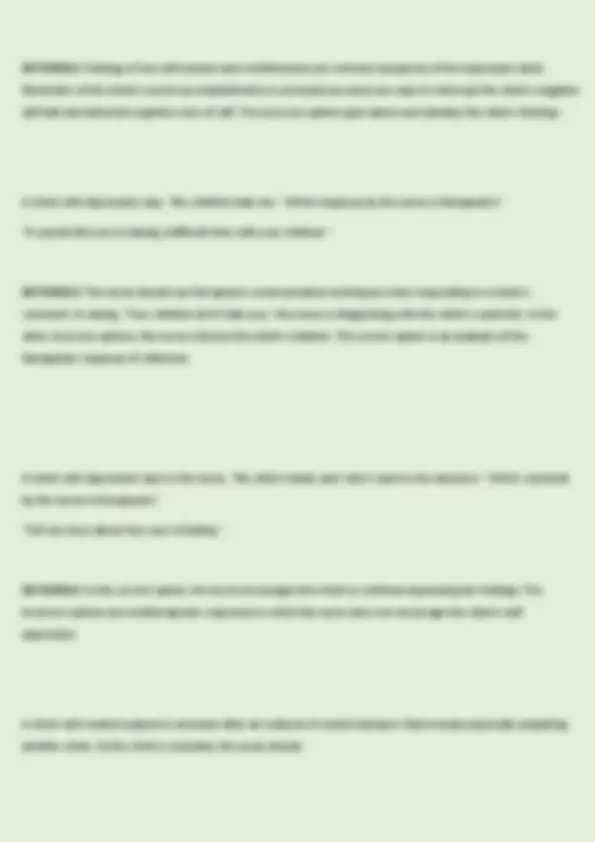
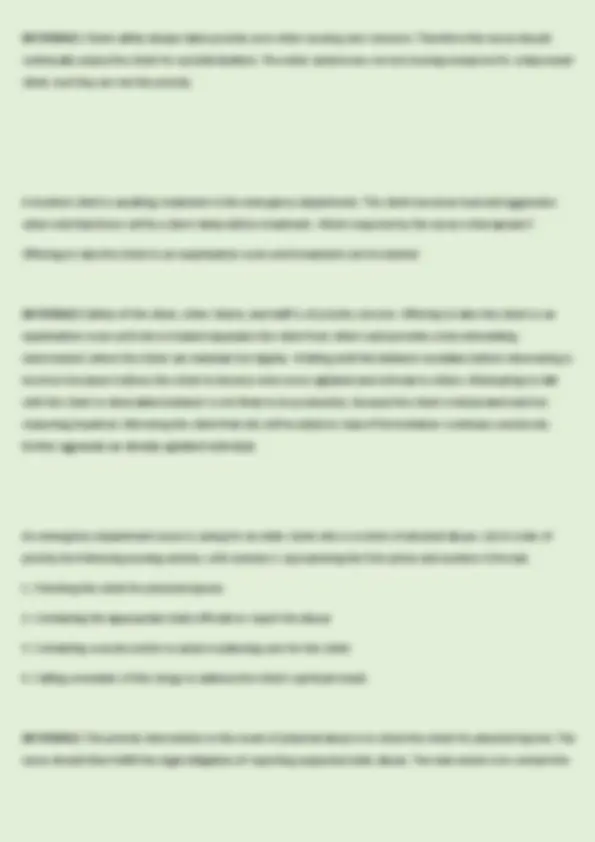
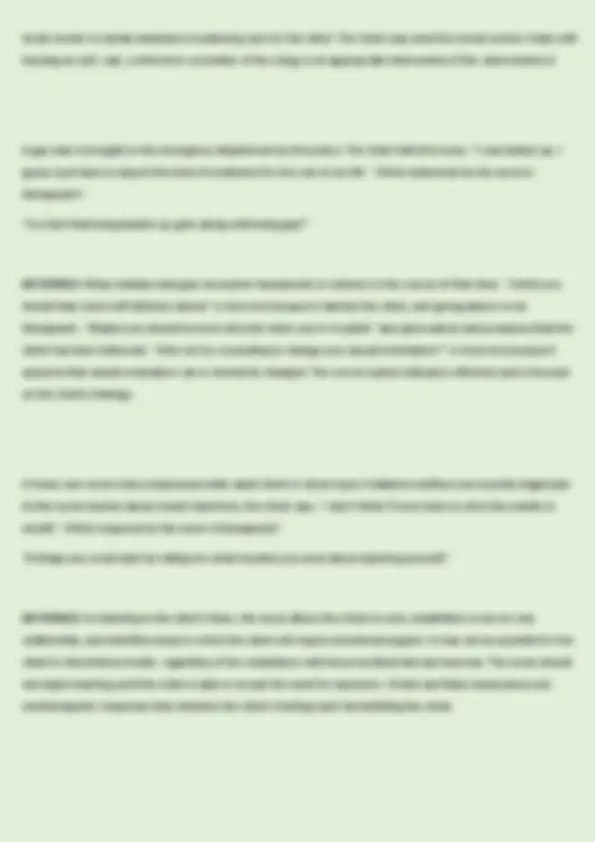
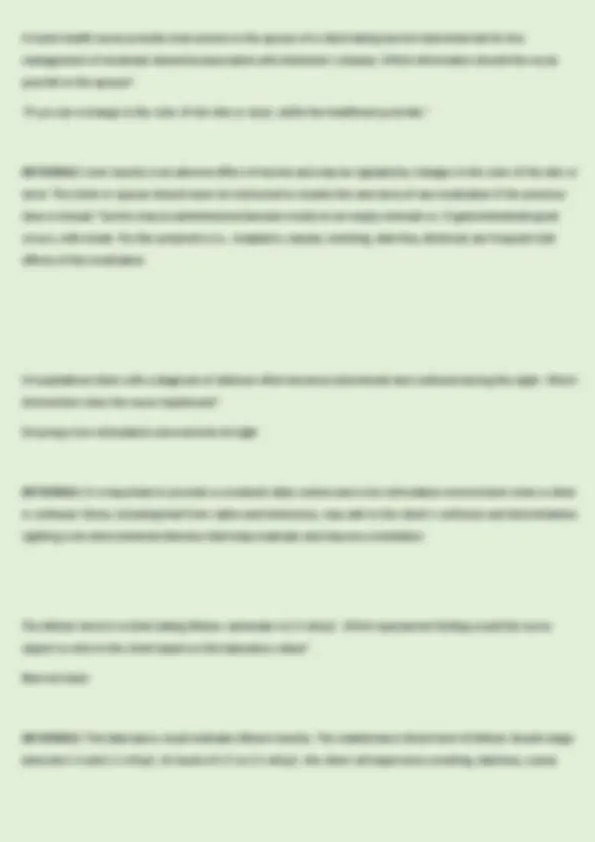
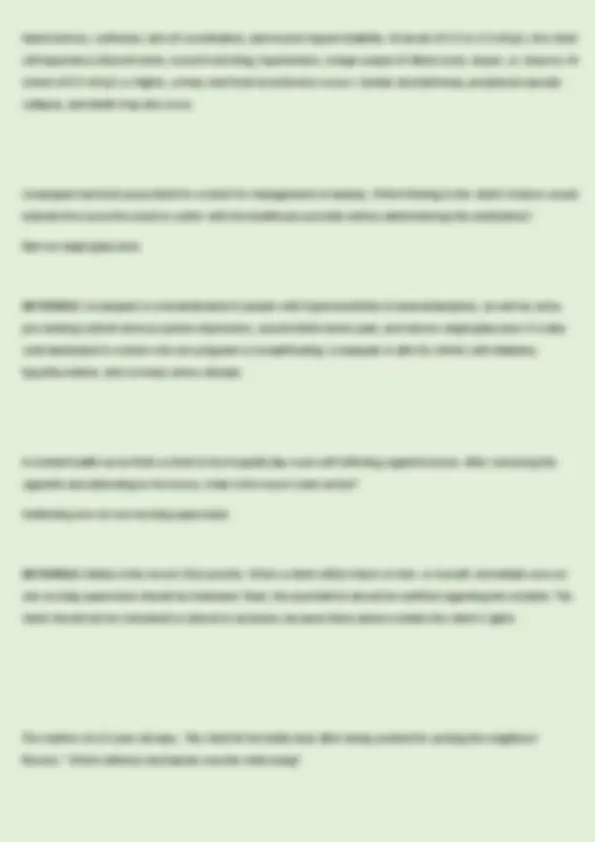
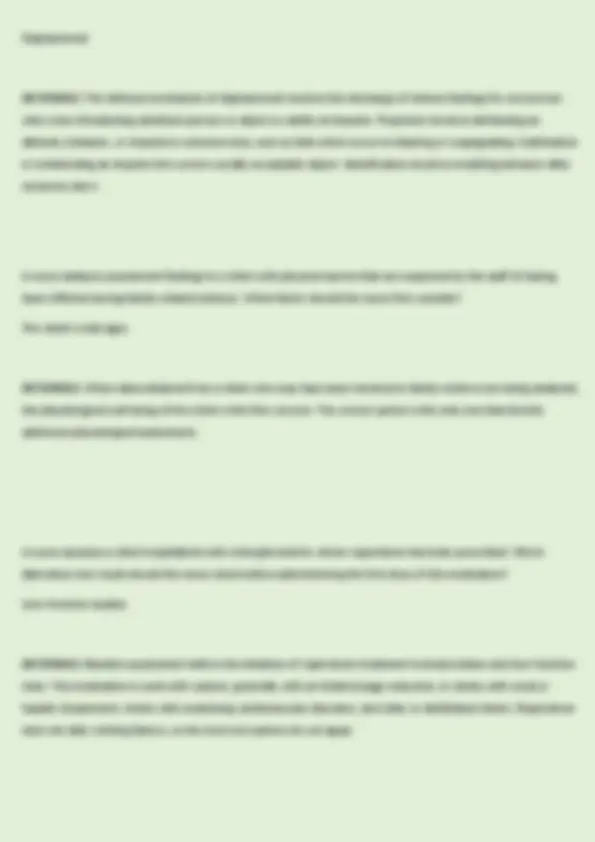
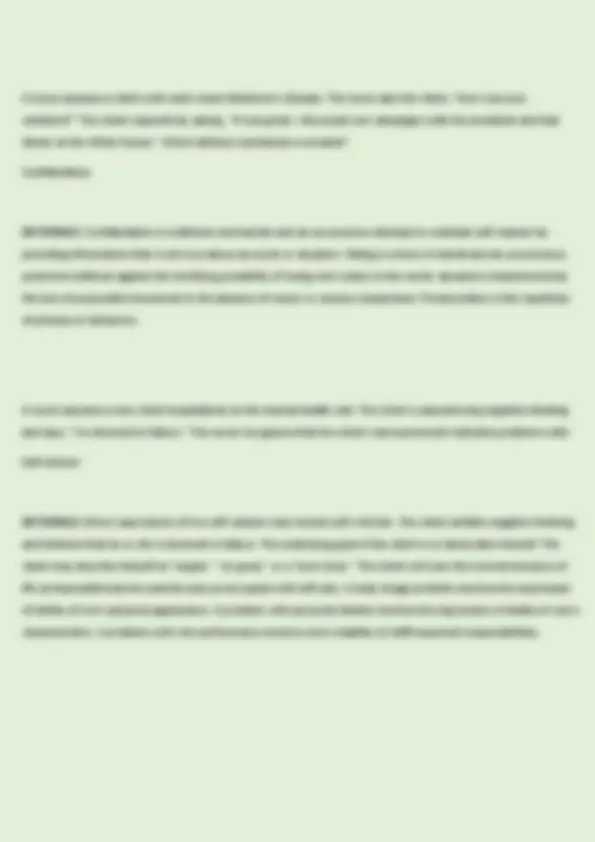
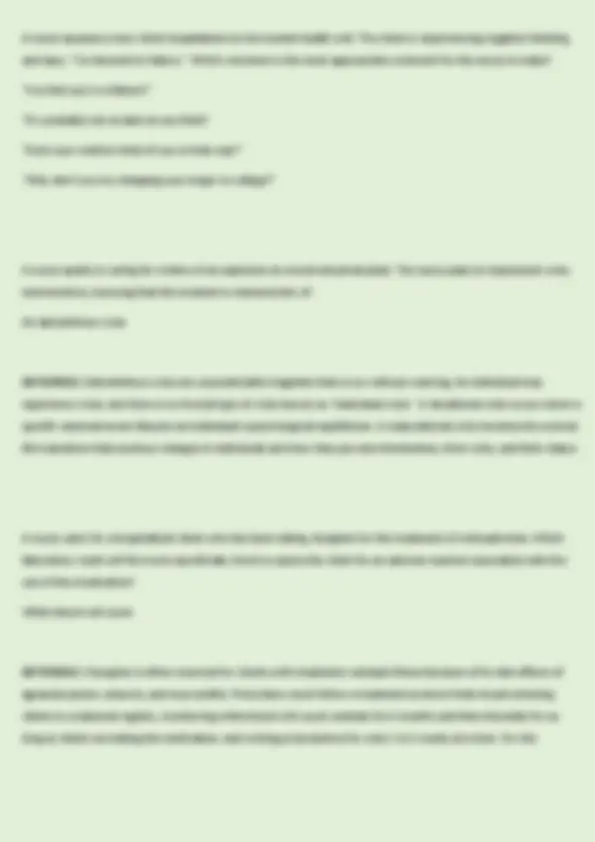
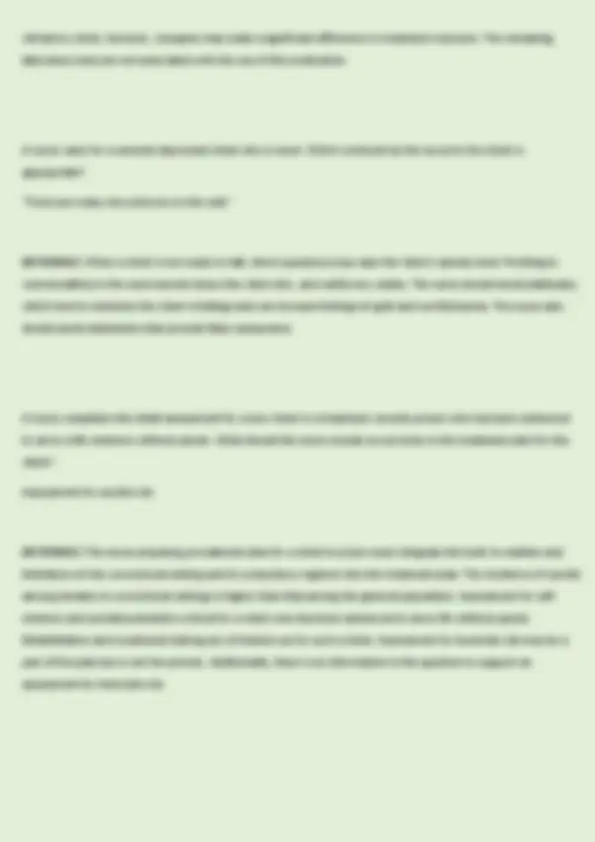
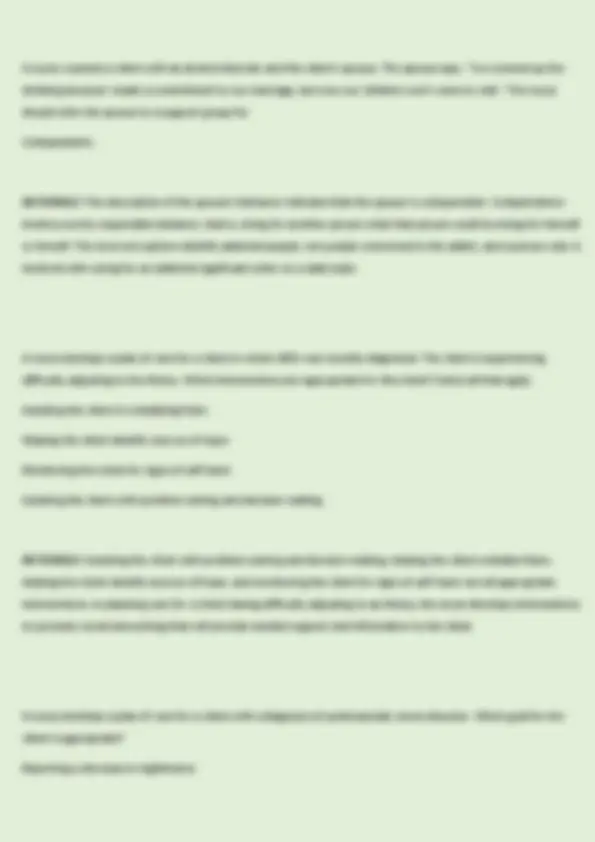
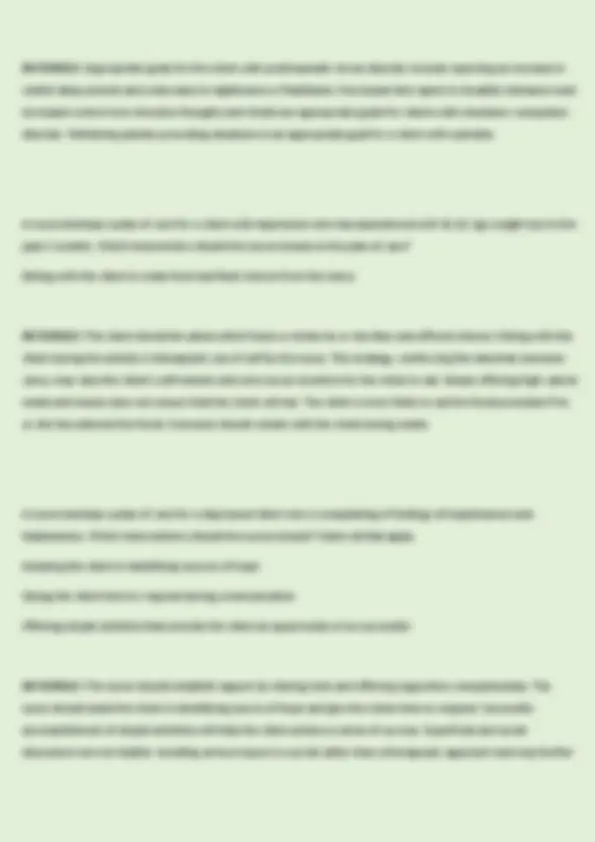
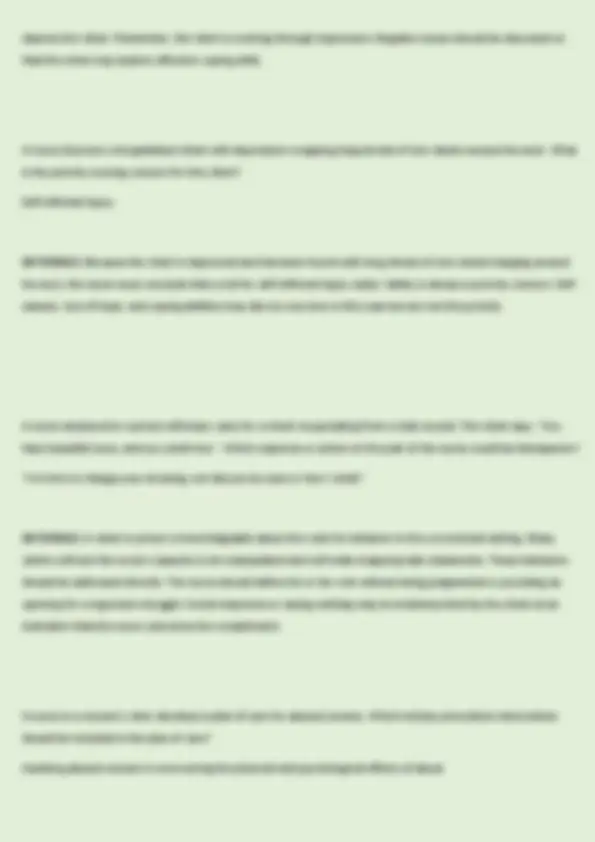
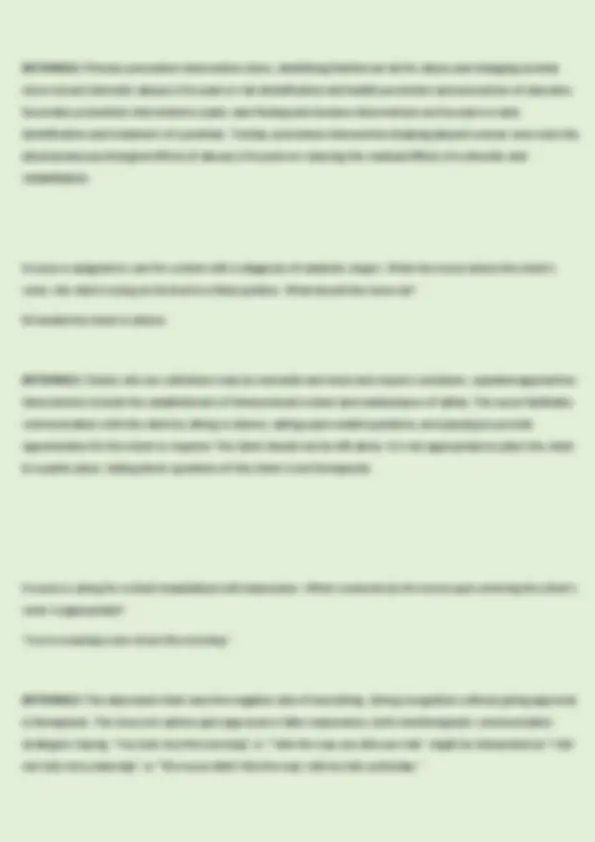
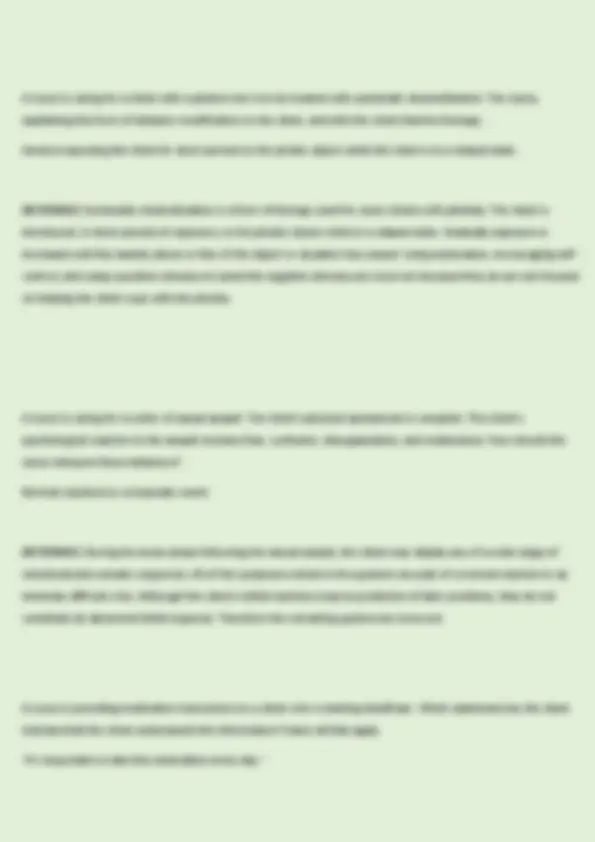
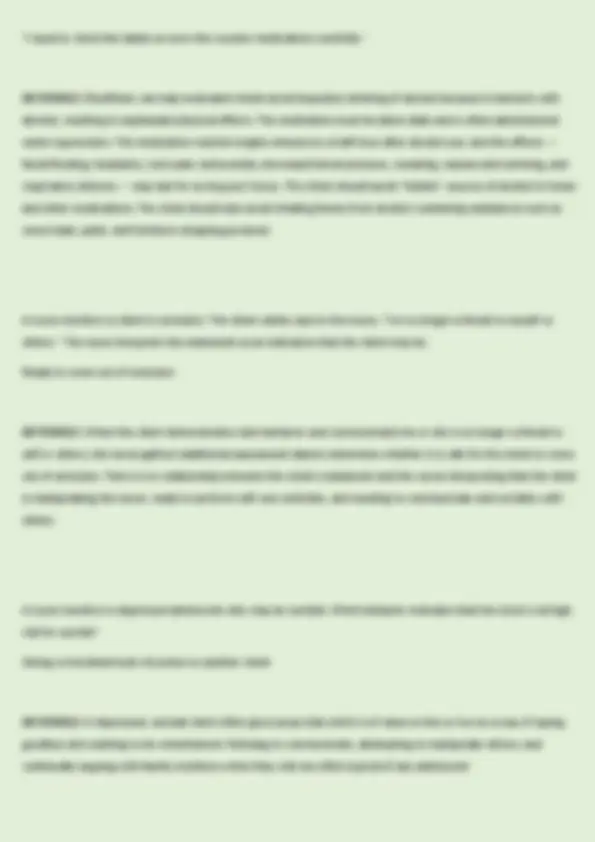
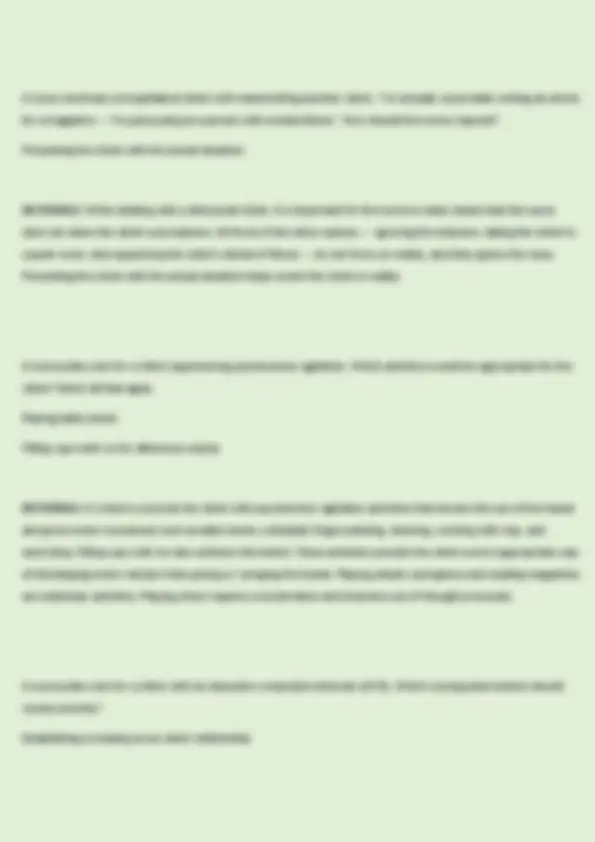
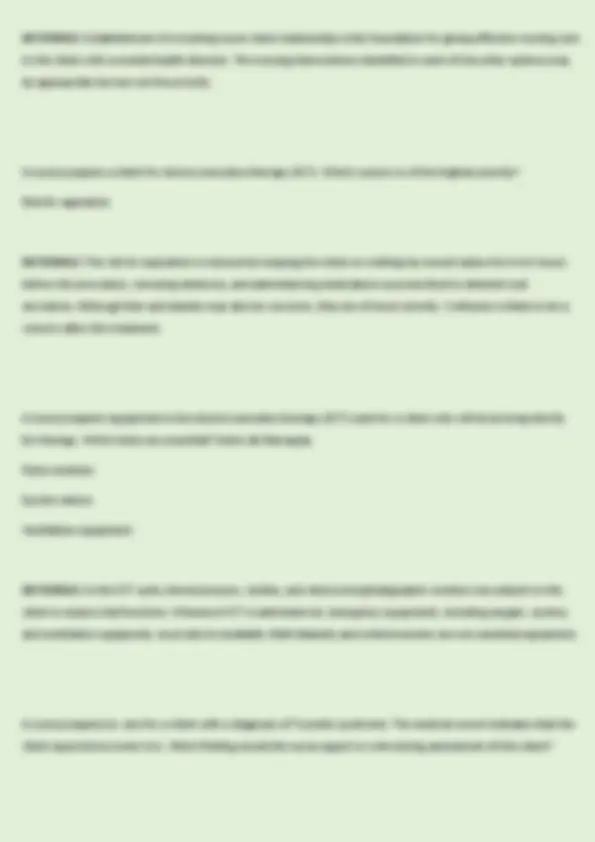
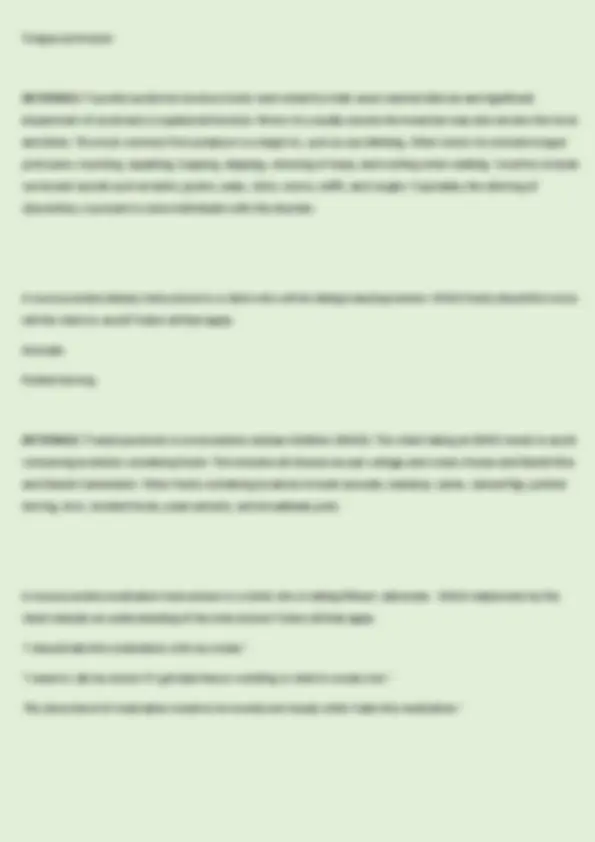
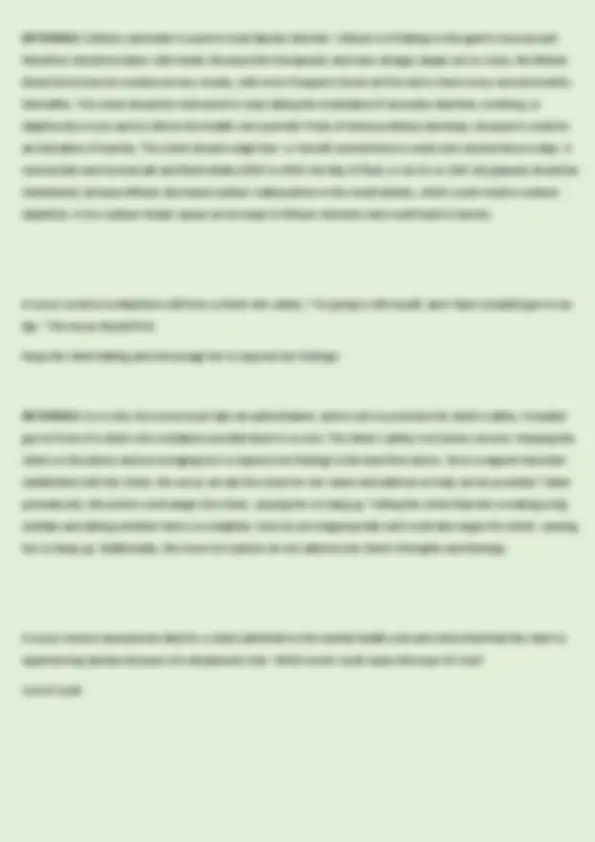
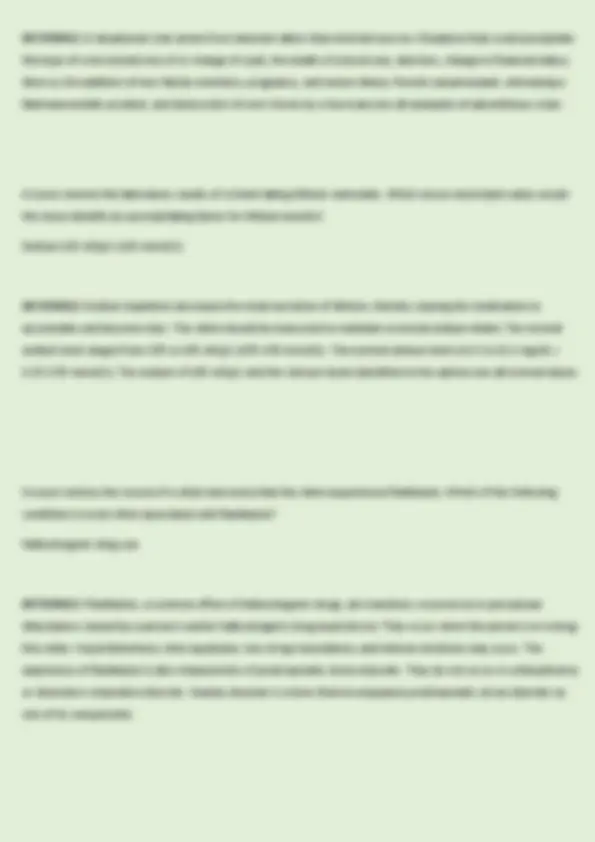
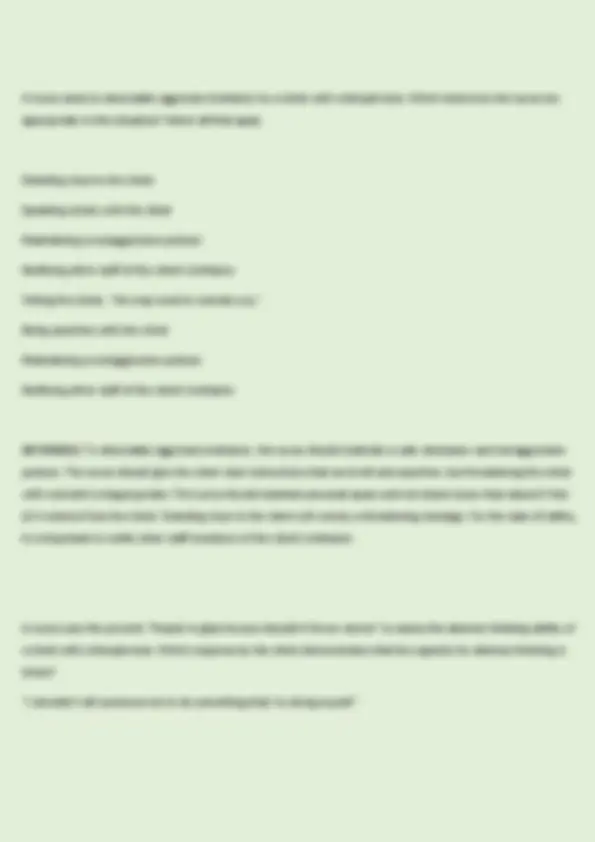
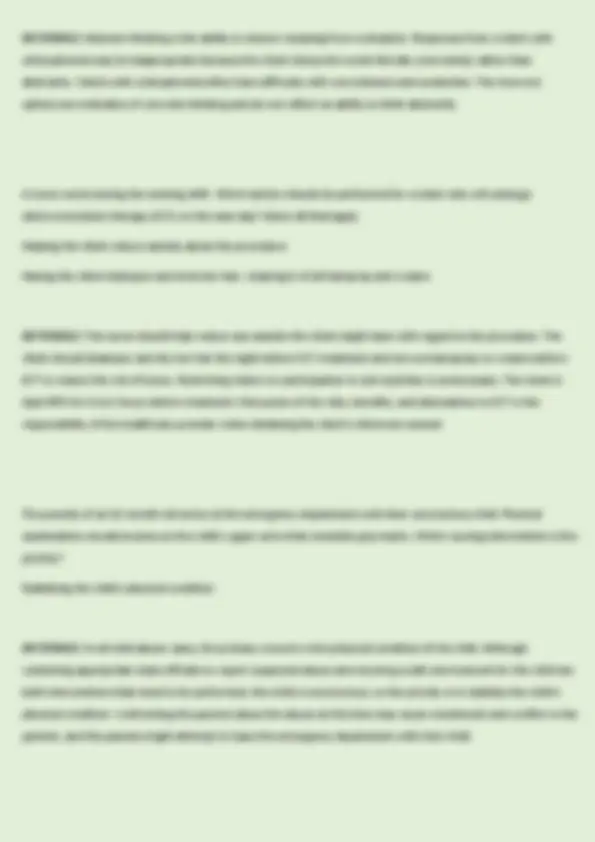
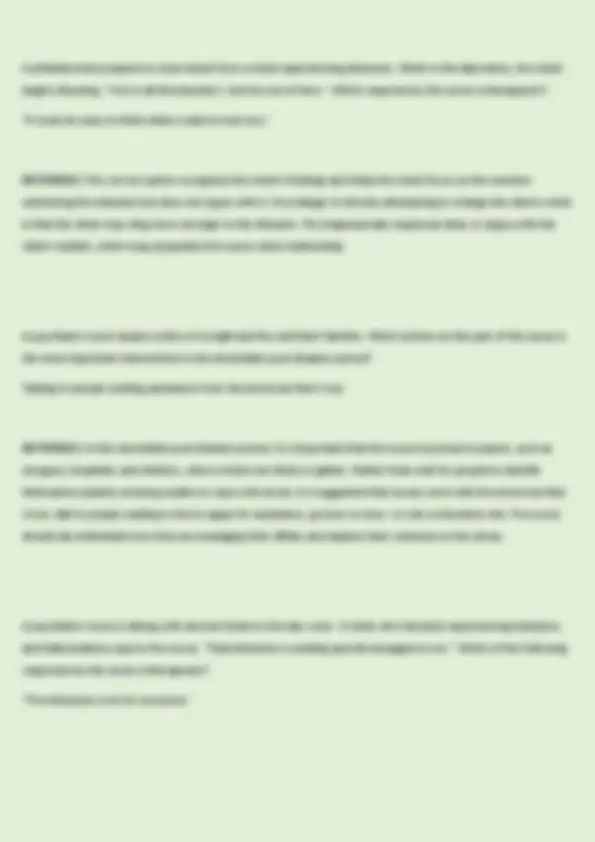
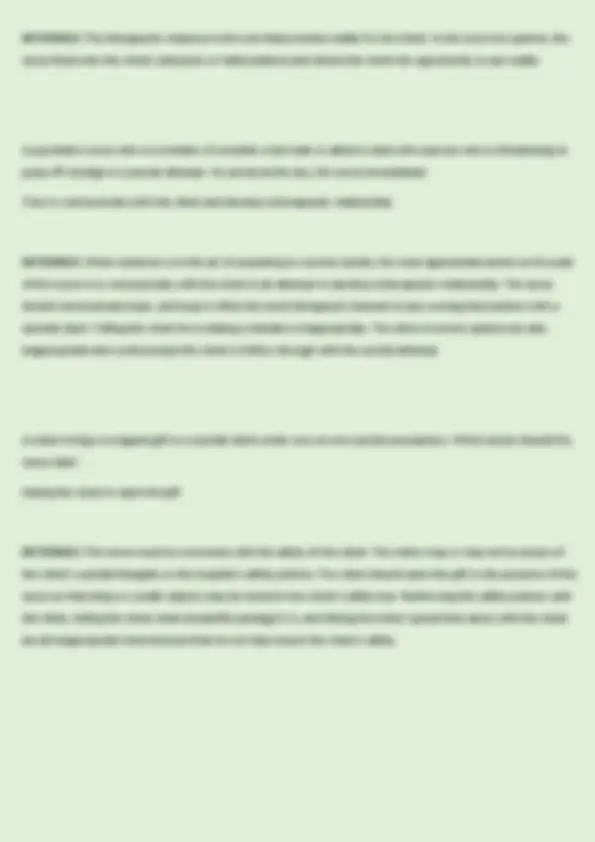
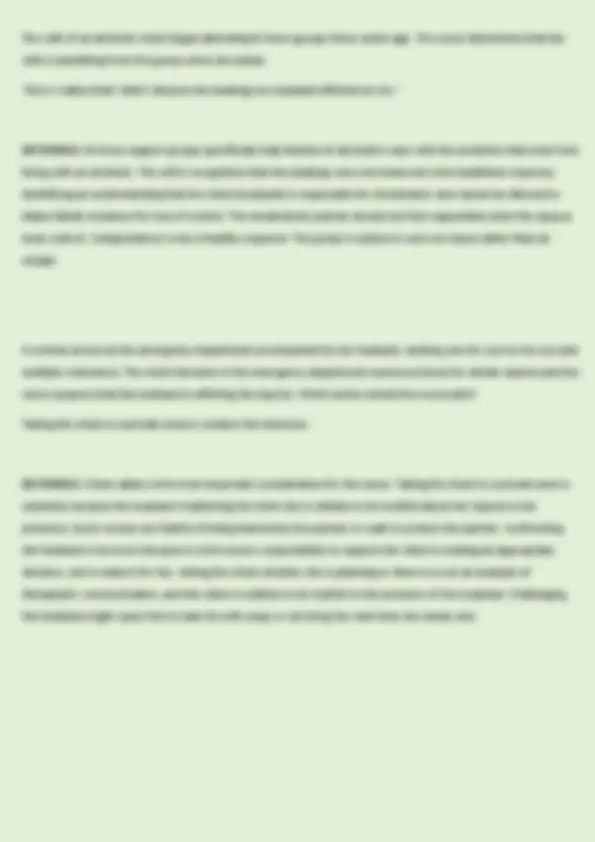


Study with the several resources on Docsity

Earn points by helping other students or get them with a premium plan


Prepare for your exams
Study with the several resources on Docsity

Earn points to download
Earn points by helping other students or get them with a premium plan
Community
Ask the community for help and clear up your study doubts
Discover the best universities in your country according to Docsity users
Free resources
Download our free guides on studying techniques, anxiety management strategies, and thesis advice from Docsity tutors
MENTAL HEALTH NCLEX-STRUCTURED QUESTIONS AND ANSWERS WITH DETAILED RATIONALES UPDATE 2025-2026
Typology: Exams
1 / 41

This page cannot be seen from the preview
Don't miss anything!


































After an attack in a park while jogging, a client experiences posttraumatic stress disorder. The client, visibly anxious, tells the nurse that she now avoids all exercise and parks but says, "I don't want to feel this way." Which response by the nurse is appropriate?
"I can see that you're upset about this. Let's talk some more about it."
RATIONALE; The therapeutic response encourages the client's expressions of feelings by indicating that the nurse is aware of the client's feelings and promoting continued communication. Each of the incorrect options neither acknowledges the client's concerns nor encourages further communication. Giving advice and false reassurance are not therapeutic techniques.
Amitriptyline hydrochloride has been prescribed for a client with depression, and the nurse provided medication instructions. Which statements by the client indicate that the teaching was effective? Select all that apply.
"I can chew sugarless gum if my mouth feels dry."
"I'm allowed to eat prunes every other day to prevent constipation."
RATIONALE; Amitriptyline is a tricyclic antidepressant. It has anticholinergic effects, including dry mouth and constipation. Sugarless gum and high-fiber foods may produce relief from these side effects. This medication has sedative effects, so a single maintenance dose is usually taken at bedtime. All of the other client statements regarding this medication indicate misinformation on the part of the client. It will take several weeks for the client to experience relief from depression. Selected cheese products should be avoided by the client taking monoamine oxidase inhibitors (MAOI) antidepressants, not tricyclics.
As the nurse prepares a client for a coronary artery bypass graft, the client asks, "Will I be OK?" Which response by the nurse is therapeutic?
"Let's talk about how you're feeling."
RATIONALE; The correct response offers self and encourages the client to share feelings and fears. The incorrect options block communication and may increase the client's anxiety. False reassurance is nontherapeutic. The client needs an opportunity to talk about the impending surgery.
Buspirone hydrochloride is prescribed for a client with an anxiety disorder. The nurse, providing information to the client about the medication, should tell the client that:
Mild dizziness and nervousness may occur
RATIONALE; Buspirone hydrochloride is used in the management of anxiety disorders. Dizziness, nausea, headaches, nervousness, lightheadedness, and excitement, which generally are not major problems, are side effects of the medication. The advantage of this medication is that it is not sedating or addicting. The medication takes 2 to 4 weeks for therapeutic effects to appear.
A client admitted to the mental health unit with depression is unclean, has body odor, and is inappropriately dressed. An accompanying family member is embarrassed about the client's appearance. When planning care, it is most important for the client and family member to understand that:
The nurse will help the client meet hygiene needs until the client is able to do so
RATIONALE; Both the client and family need to know that the nurse will assist the client until is able to resume self-care activities. A client with depression has decreased energy and is subject to psychomotor retardation, so, assistance is necessary. Indicating that self-esteem needs to take priority over appearance, that hygiene is not
Conversion disorde
RATIONALE; A conversion disorder is an alteration or loss of a physical function that cannot be explained by any known pathophysiological mechanism. It is often an expression of a psychological need or conflict. Psychosis is a state in which a person's mental capacity to recognize reality, communicate, and relate to others is impaired, thus interfering with the person's capacity to deal with life demands. Repression is a coping mechanism in which unacceptable feelings are kept out of awareness. A dissociative disorder is a disturbance or alteration in the normally integrative functions of identity, memory, or consciousness.
A client has a diagnosis of dependent personality disorder. Which goal is most appropriate for this client?
Using the problem-solving process effectively
RATIONALE; The client with dependent personality disorder exhibits an unusually strong need to be cared for and has difficulty making personal choices and every day decisions in fear of making the wrong decision. An appropriate goal would be for the client to use the problem-solving process effectively in everyday situations. The client described in the question does not exhibit any suicidal traits, nor does he suffer from an obsessive- compulsive personality disorder or an anxiety disorder.
A client hospitalized in a mental health unit is restrained after becoming extremely violent. Which finding indicates to the nurse that the client can be removed from the restraints?
The client initiates no aggressive acts for 30 minutes after the release of two leg restraints
RATIONALE; The best indicator that the client's behavior is under control is when the client refrains from aggression after partial release from the restraints. Generally a structured reintegration, begun by reducing a client's four-point restraints to two-point restraints, is initiated. If the client continues to exhibit nonaggressive
behavior, the remaining restraints are removed. The incorrect options are not indicators that the client's behavior is under control.
A client hospitalized with schizophrenia says to the nurse, "Get your goat. Go out and vote. Don't be a cut throat. Row your boat." How should the nurse document the client's behavior?
Clang associations
RATIONALE; Repetition of words or phrases that are similar in sound but in no other way, known as clang association, is an assessment finding in some clients with schizophrenia. Clang associations often take the form of rhyme. Echolalia, the pathological repeating of another's word, is often seen in people with catatonia. Word salad is a mixture of phrases that is meaningless to the listener and perhaps to the speaker as well. Thought broadcasting is the belief that others can know one's thoughts.
A client hospitalized with severe depression is withdrawn and exhibits poor motivation and concentration. Which activity should the nurse plan for this client?
Drawing
RATIONALE; When a client is severely depressed, the client should be involved in activities that require little concentration and have no elements of being "right" or "wrong." As the client's condition improves, the client may become involved in activities with small groups, such as cooking class, dance therapy, and small group discussions.
RATIONALE; Agoraphobia is a fear of open spaces and the fear of being trapped in a situation from which there may not be an escape. Agoraphobia includes the possibility of experiencing a sense of helplessness or embarrassment if a phobic attack occurs. Avoidance of such situations usually results in a reduction in social and professional interactions. Social phobia is focused more on a specific situation, such as the fear of speaking, performing, or eating in public. Clients with hypochondriacal symptoms focus their anxiety on physical complaints and are preoccupied with their health. Claustrophobia is a fear of closed-in places.
A client on the mental health unit says to the evening nurse, "The staff on the day shift let me smoke two cigarettes. You only let me smoke one." Which response by the nurse is therapeutic?
"The policy is one cigarette. We'll follow the policy."
RATIONALE; The correct option is therapeutic because it provides the client with a clear and direct response regarding the policy on the unit. In the incorrect options, the nurse criticizes the day shift staff.
A client prepares to attend an Alcoholics Anonymous meeting for the first time. Which step, the first in the 12- step program, should the nurse discuss with the client?
Admitting to having a problem
RATIONALE; The first step in the 12-step program is admitting that a problem exists. Stating that drinking will stop and discontinuing relationships with friends who drink are unrealistic as first steps in the process to recovery. Although identifying healthy alternatives to drinking may be a useful strategy, it is not the first step.
A client says, "I have so much trouble caring for my husband's child from his first marriage. I resent the money we have to pay for child support because we have to deprive my own child of things. How can I stop feeling this way?" Which response by the nurse is therapeutic?
"Have you shared your feelings with your husband?"
RATIONALE; Remarried individuals often encounter problems as a result of the stressors they bring into a marriage without prior discussion with the new partner. Bonding sometimes does always occur when a child is not one's biological offspring. The correct answer is focused on the client's feelings. "Your child benefits from having a sibling" is not facilitative. "I wonder why you married him, knowing that he wouldn't desert his biological child" is incorrect because it prejudges the client. "You need to take a second job to give your child what you think she deserves" is not open ended, does not facilitate feelings, and gives advice.
A client says, "I spend hours each evening reviewing my day to see whether I behaved appropriately or should have done something differently. I tell myself to snap out of it, but I'm still doing it! It takes me 2 or 3 hours each morning to get dressed, because I want my clothes to be just right." Which problem is evident in these statements?
Obsessive-compulsive disorder
RATIONALE; Obsessions are persistent intrusive thoughts that the affected person tries to ignore or suppress. This client wants to "snap out of" this daily review, but the thoughts continue for hours. Compulsions are repetitive behaviors that the client feels driven to perform, such as changing clothes frequently until they are "just right." Agoraphobia, major depression, and attention deficit-hyperactivity disorder are not associated with the characteristics described in the question.
A client says, "I've had so many crying spells over the past several weeks. My doctor says it's probably depression." The nurse sees that the client is sitting slumped in the chair and that the client's clothing is baggy. Further assessment of this client should be focused on:
RATIONALE; The nurse is responsible to clarify the client's statement, even though it is a passive one of low lethality. In the correct option, the nurse uses the therapeutic communication technique of focusing and questioning. This option also allows the nurse to assess the suicidal ideation passively expressed by the client. Giving advice is a nontherapeutic communication technique that does not allow the nurse to assess the potential for suicide. The incorrect options, respectively, are directive, judgmental, and falsely reassuring. (Also, the "silver lining" comment is a cliché.
A client says to the nurse, "My cancer is going to shorten my life, so I'm making a will that leaves my money to charity. Do you think I can get into heaven that way?" Which response by the nurse is therapeutic?
"You feel that a charitable contribution will get you into heaven if your cancer ends your life?"
RATIONALE; The correct option involves the therapeutic communication technique of reflection, in which the ideas of the client are presented back to the client for the client to consider. It is employed when a client asks the nurse for approval or judgment because it helps the nurse intervene with a nonjudgmental response. The client is expressing concern, and, although the illness may be cured, it is vital to actively listen and to be sensitive to expression of concerns and fear. The incorrect options give an opinion, express approval, use false reassurance, or offer advice and lectures to the client, all of which are closed-ended techniques that do not facilitate expressions of feelings.
A client says to the nurse, "My wife retired last year from a lucrative law practice, and I'm really discouraged. I'll be working until I die, even though I helped pay for her education." Which response by the nurse is supportive?
"You sound very troubled by this."
RATIONALE; Saying that the situation is unfair is judgmental and does not encourage the client to express his feelings; nor does "That's such a tough break for you." Suggesting that the husband approach the spouse for help is incorrect because it prematurely gives advice, a nontherapeutic communication technique. The correct option is focused on the client's feelings.
A client states to a nurse, "I feel like putting an end to my misery." How should the nurse respond to the client?
"Tell me more about what you feel like doing."
RATIONALE; All suicidal threats must be taken seriously, and their meaning must be thoroughly explored. Clichés and false reassurance block communication and devalue the client. "Why" questions request an explanation from the client when the client may not have one.
A client tells the nurse, "I did my hair just like my favorite math teacher wears hers. I hope I can be a good teacher, too." Which defense mechanism is the client using?
Identification
RATIONALE; Identification is the process in which a person tries to become like someone he or she admires by taking on the thoughts, mannerisms, or tastes of that person. Projection is attributing one's thoughts or impulses to another person. Regression is retreating to behavior characteristic of an earlier level of development. Intellectualization is the use of excessive reasoning or logic in an attempt to avoid disturbed feelings.
A client, upset, says, "My ex-wife's new husband is being relocated to a job across the country, so now I'll only see my child on holidays and school vacations." Which response by the nurse is therapeutic?
"This must be very difficult for your child to move away from you, school, and friends."
A client whose spouse recently died is experiencing dysfunctional grieving. Which intervention has priority in the plan of care?
Assessing the client's risk for violence toward self and others
RATIONALE; The priority intervention for a client with dysfunctional grieving is assessment of the client's risk for violence toward self and others. Although the nurse will assist the client in resolving the grief and monitor the client's sleep pattern, these are not the priority interventions of the options given. Obtaining a prescription for an antidepressant is not a priority.
A client with a panic disorder has been medicated with alprazolam.Which assessment finding suggests that the client is experiencing a side effect of the medication?
Confusion
RATIONALE; Alprazolam is an antianxiety agent (benzodiazepine) used in the short-term management of panic disorder. Central nervous system side effects include disorientation, confusion, drowsiness, and clumsiness. Increased anxiety is not a side effect of the medication. The medication can cause both physical and psychological dependence, so it is used with caution.
A client with a personality disorder will begin recreational therapy as a component of the treatment plan. This treatment modality is most helpful for clients who:
Have difficulty socializing
RATIONALE; Recreational therapy helps clients with personality disorders explore ways to enjoy themselves without the use of self-destructive behaviors such as the abuse of alcohol or drugs. This modality is helpful to
clients who have difficulty socializing, because recreation strengthens social skills. Art therapy may be helpful for a client with anger issues. The client who is exhibiting violent behavior may require medication therapy. Movement therapy may be helpful for clients who become "numb" when experiencing intense feelings.
A client with bipolar disorder has been hospitalized for 4 days. Today in group therapy the client offered helpful suggestions in regard to another client's problem. The nurse concludes that the client's behavior is representative of
Improvement
RATIONALE; The behavior demonstrated by the client is appropriate during hospitalization. There is no evidence in the question that the client is acting out (which is an attention-seeking behavior), being manipulative, or seeking attention.
A client with delirium suddenly picks up a can of soda from the meal tray and threatens to throw it at the nurse. How should the nurse respond?
"Hitting me or anyone else is not allowed."
RATIONALE; When a client's behavior becomes physically abusive, the nurse must set limits on the behavior. Communication with a client experiencing delirium should be simple and clear. The incorrect options threaten the client and jeopardize the client's rights.
A client with depression says, "I always make mistakes. I never do anything right." Which response by the nurse is therapeutic?
Identifying recent accomplishments that demonstrate the client's abilities
Inform the client, "You are being secluded to help you regain control of yourself"
RATIONALE; The client is removed to a nonstimulating environment because of his or her behavior. It is best to inform the client directly of the purpose of the seclusion. Remaining silent because verbal interaction would be too stimulating, telling the client he or she is not allowed to rejoin the others until able to behave, and asking the client whether he or she understands why the seclusion are all nontherapeutic approaches. Not letting the client rejoin the others also implies punishment.
A client with obsessive-compulsive disorder is hospitalized because his ritualistic behaviors have become so time- consuming that the client is unable to maintain employment. The initial priority nursing intervention is to:
Allow the client time to perform the rituals
RATIONALE; Compulsive rituals are used to manage the client's anxiety, even though the behavior is maladaptive. It is usually not helpful to interfere prematurely with a ritual unless it threatens the client's health. Providing the client with unit rules, assisting the client in carrying out rituals, and confronting the client about poor use of time are not therapeutic interventions and would increase the client's anxiety.
A client with obsessive-compulsive disorder, upset and agitated, walks repeatedly around the nursing unit, following the same route each time. The client says to the nurse, "Walk with me." Which response by the nurse is appropriate?
"I can see that you're upset. I can walk and talk with you for 15 minutes."
RATIONALE; The correct response acknowledges the client's feelings and provides an avenue for release of the client's anxieties. Each of the incorrect options is a block to communication. The wording of the incorrect options does not acknowledge the client's feelings.
A client with paranoid schizophrenia has been agitated, threatening and shouting at others, and refusing to participate in therapy. Projection and denial are evident in these behaviors. The appropriate nursing action is to:
Acknowledge the client's anxiety and then set limits on the behavior
RATIONALE; Denial is a failure to recognize what is occurring in a situation and generates inappropriate behavior. Projection involves attributing an attitude, behavior, or impulse to someone else. Setting limits on unacceptable and inappropriate behaviors in a nondefensive manner is most appropriate in this situation. It also helps ensure the safety of others. Accepting the behavior without comment, exploring past experiences of acting out with the client, and collecting information from the client to develop a database do not provide interventions that directly relate to the client's behavior,
A client with severe depression tells the nurse, "I'm feeling much better now." The client demonstrates increased interaction and energy levels. The nurse implements one-on-one supervision because the behavior indicates that the client:
Now has the energy to carry out a suicide plan
RATIONALE; The client now has the energy to act on a suicide plan. Suicidal clients may appear to be feeling better immediately before making an attempt. Some clients experience a feeling of relief when the decision to commit suicide has been made and plans have been finalized. An elopement risk, a need interpersonal support, and a need for reinforcement of positive behaviors are incorrect interpretations of the client's behaviors.
A depressed client tells the nurse, "I'm powerless, and I'm not worthy of having friends. Sometimes I take too many pills." The nurse's priority in planning care for this client is:
Continual assessments for suicidal ideation
social worker to obtain assistance in planning care for the client. The client may need the social worker's help with housing as well. Last, a referral to a member of the clergy is an appropriate intervention if the client desires it.
A gay man is brought to the emergency department by the police. The client tells the nurse, "I was beaten up. I guess I just have to expect this kind of treatment for the rest of my life." Which statement by the nurse is therapeutic?
"You feel that being beaten up goes along with being gay?"
RATIONALE; Many lesbians and gays encounter harassment or violence in the course of their lives. "I think you should take some self-defense classes" is incorrect because it advises the client, and giving advice is not therapeutic. "Maybe you should be more discreet when you're in public" also gives advice and presumes that the client has been indiscreet. "Why not try counseling to change your sexual orientation?" is incorrect because it assumes that sexual orientation can or should be changed. The correct option indicates reflection and is focused on the client's feelings.
A home care nurse visits a depressed older adult client in whom type 2 diabetes mellitus was recently diagnosed. As the nurse teaches about insulin injections, the client says, "I don't think I'll ever learn to stick this needle in myself." Which response by the nurse is therapeutic?
"Perhaps you could start by telling me what troubles you most about injecting yourself."
RATIONALE; In listening to the client's fears, the nurse allows the client to vent, establishes a one-on-one relationship, and identifies areas in which the client will require emotional support. It may not be possible for the client to discontinue insulin, regardless of his compliance with the prescribed diet and exercise. The nurse should not begin teaching until the client is able to accept the need for injections. Clichés and false reassurances are nontherapeutic responses that minimize the client's feelings and risk belittling the client.
A home health nurse provides instructions to the spouse of a client taking tacrine hydrochloride for the management of moderate dementia associated with Alzheimer's disease. Which information should the nurse provide to the spouse?
"If you see a change in the color of the skin or stool, notify the healthcare provider."
RATIONALE; Liver toxicity is an adverse effect of tacrine and may be signaled by changes in the color of the skin or stool. The client or spouse should never be instructed to double the next dose of any medication if the previous dose is missed. Tacrine may be administered between meals on an empty stomach or, if gastrointestinal upset occurs, with meals. Flu-like symptoms (i.e., headache, nausea, vomiting, diarrhea, dizziness) are frequent side effects of the medication.
A hospitalized client with a diagnosis of delirium often becomes disoriented and confused during the night. Which intervention does the nurse implement?
Ensuring a low-stimulation environment at night
RATIONALE; It is important to provide a consistent daily routine and a low-stimulation environment when a client is confused. Noise, including that from radios and televisions, may add to the client's confusion and disorientation. Lighting is an environmental stimulus that helps maintain and improve orientation.
The lithium level in a client taking lithium carbonate is 2.3 mEq/L. Which assessment finding would the nurse expect to note in the client based on this laboratory value?
Blurred vision
RATIONALE; This laboratory result indicates lithium toxicity. The maintenance blood level of lithium should range between 0.4 and 1.3 mEq/L. At levels of 1.5 to 2.0 mEq/L, the client will experience vomiting, diarrhea, coarse